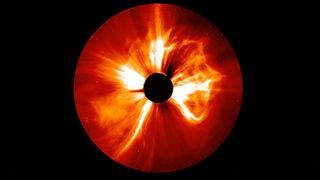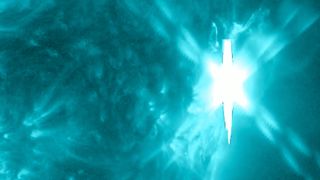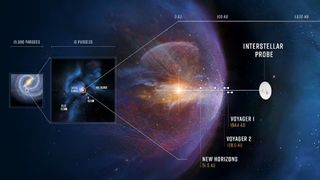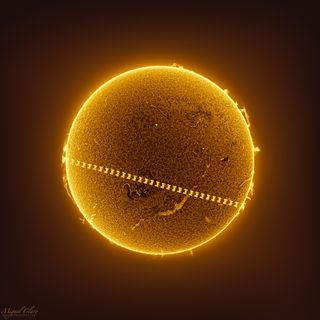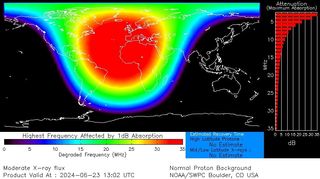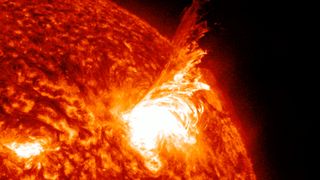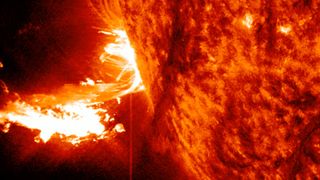On Tuesday (July 23), Europe’s Solar Orbiter (SolO) spacecraft witnessed an extremely powerful X14 class solar flare erupt from the far side of the sun. Although it was not the most powerful flare ever recorded, which was estimated at roughly a X45 back in 2003, solar flares of this magnitude can result in longer-lived radiation storms and even world-wide blackouts if they are directed at Earth. The X-class are the leaders on the classification scale, and blast out energy 10 times more powerful than M class flares, which is second…
Read MoreTag: The Sun
Sun blasts out 2nd X-class flare this week, triggers more radio blackouts (video)
The sun continues firing off solar flares during what has been a period of intense activity. Sunspot AR3738 might be making its exit as it rotates out of our view on the sun’s western limb, but not before firing off a powerful X-class solar flare, the strongest of its kind. The solar flare from sunspot AR3738 occurred Tuesday morning (July 16) at 9:26 a.m. EDT (1326 GMT). A shortwave radio blackout in conjunction with the latest event was reported over mostly the Atlantic Ocean and also noted across much of Africa, Europe, and…
Read MoreScientists call the region of space influenced by the sun the heliosphere – but without an interstellar probe, they don’t know much about its shape
This article was originally published at The Conversation. The publication contributed the article to Space.com’s Expert Voices: Op-Ed & Insights. Sarah Spitzer is a research fellow in Climate and Space Sciences and Engineering at the University of Michigan. The sun warms the Earth, making it habitable for people and animals. But that’s not all it does, and it affects a much larger area of space. The heliosphere, the area of space influenced by the sun, is over a hundred times larger than the distance from the sun to the Earth. The sun is a…
Read MoreSolar maximum is in sight but when will it arrive (and when will we know)?
May and June 2024 saw the highest sunspot numbers on the sun since 2002, but is the peak of the solar cycle here yet? The sun follows an 11-year solar cycle of increasing and decreasing activity. Although not the first astronomer to discover the solar cycle, the solar cycle numbering and naming convention was first introduced in 1852 by Swiss astronomer Johann Rudolf Wolf. Within his new solar cycle numbering system, he set the historic 1755-1766 solar cycle ‘Solar Cycle 1’. By the time of his work, the sun was…
Read MoreCelebrate the Heliophysics Big Year with Free Heliophysics and Math Webinars from NASA HEAT
2 min read Celebrate the Heliophysics Big Year with Free Heliophysics and Math Webinars from NASA HEAT The Heliophysics Big Year (HBY) is a global celebration of the Sun’s influence on Earth and the entire solar system. It began with the Annular Solar Eclipse on Oct. 14, 2023, continued through the Total Solar Eclipse on Apr. 8, 2024, and will conclude with Parker Solar Probe’s closest approach to the Sun in December 2024. Challenged by the NASA Heliophysics Division to participate in as many Sun-related activities as possible, the NASA…
Read MoreSee the sun rage behind the ISS in epic time-lapse photo
Miguel Claro is a professional photographer, author and science communicator based in Lisbon, Portugal, who creates spectacular images of the night sky. As a European Southern Observatory Photo Ambassador and member of The World At Night and the official astrophotographer of the Dark Sky Alqueva Reserve, he specializes in astronomical “Skyscapes” that connect both Earth and the night sky. This image shows the silhouette of the International Space Station (ISS) as it crosses in front of the sun’s disk at a distance of 274 miles (441.5 km) from us and at a speed of about 4.5 miles…
Read MoreIt’s back! Aurora-sparking sunspot returns for rare 3rd trip across the sun, firing off explosive solar flare (video)
The historic sunspot region that sparked the record-breaking auroras of May 2024 has returned in explosive fashion, firing off a colossal M9.3 class solar flare on June 23. But this isn’t the first time we have encountered this hyperactive sunspot. AR3723 is the returning version of sunspot AR3697 and before that AR3664 — which was responsible for the colossal G5 geomagnetic storm that triggered epic auroras around the world. The sun‘s rotation period averages 27 days, which means Earth can view a given active region for around two weeks before…
Read MoreMore people Googled ‘northern lights’ in May 2024 than in any other month in history
The terms ‘northern lights’, ‘space weather‘ and ‘geomagnetic storm’ were googled more in May 2024 than in any other month in the search engine’s history. With April’s total solar eclipse, and Mid-May’s widespread aurora show, public interest in the sun has been much higher than usual. As photos and discussions of the eclipse and northern lights flooded social media and secured segments on prime-time news broadcasts, Google search inquiries for these topics shot up significantly. Using the Google Trends feature, we can utilize Google search statistics to track how public…
Read MoreSun unleashes giant plasma plume and reels it back in apparent ‘failed eruption’ (video)
The sun erupted in a dazzling spectacle on Monday (June 3), firing off an intense solar flare captured in stunning detail by a NASA solar observatory. But when you look closely at the eruption, it appears that much of the solar material in the vast plasma plume didn’t manage to escape the grasp of the sun. In the video, captured by NASA’s Solar Dynamics Observatory during an M-class solar flare, you can see a huge plasma plume rise from the sun’s surface, only to be reeled back in during an…
Read MoreColossal X-class solar flare suggests return of sunspot group that fueled May’s epic auroras (video)
The colossal sunspot group AR3664 responsible for the epic May 2024 solar storms and widespread auroras is back — well, almost. Yesterday (May 27), a powerful X-class solar flare erupted from the sun‘s southeastern limb, peaking around 3:08 a.m. EDT (0708 GMT). Solar flares are energetic eruptions of electromagnetic radiation from the sun’s surface that occur when magnetic energy accumulating in the solar atmosphere is released. They are categorized by size into lettered groups, with X-class being the most powerful. Within each class, numbers from 1-10 (and beyond for X-class…
Read More